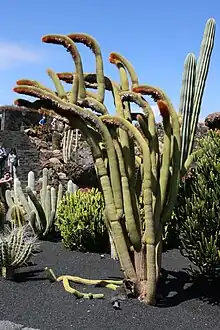Vatricania
Vatricania is a monotypic genus of flowering plants belonging to the family Cactaceae. It contains just one species, Vatricania guentheri.[2] It has the common name of red tail cactus.[3][4]
| Vatricania | |
|---|---|
 | |
| In cultivation in the Jardin de Cactus, Lanzarote | |
| Scientific classification | |
| Kingdom: | Plantae |
| Clade: | Tracheophytes |
| Clade: | Angiosperms |
| Clade: | Eudicots |
| Order: | Caryophyllales |
| Family: | Cactaceae |
| Subfamily: | Cactoideae |
| Tribe: | Cereeae |
| Subtribe: | Trichocereinae |
| Genus: | Vatricania Backeb. |
| Species: | V. guentheri |
| Binomial name | |
| Vatricania guentheri (Kupper) Backeb.[1] | |
| Synonyms[1] | |
| |
Its native range is Bolivia.[2][3] It is found in dry forest vegetation or covering hillsides, at altitudes of 800–1,300 metres (2,600–4,300 ft) metres above sea level.[5]
Description
Vatricania guentheri is an evergreen, perennial columnar cactus.[3][4][6] It can grow up to 2 m (6 ft 7 in) tall.[3] Branching occurs from the base, with pale green stems up to 10 cm (4 in) in diameter.[4] It has about 27 ribs.[3][4][6] The flowers are initially borne in a cephalium (reddish brown wool,[4]) running down from the crown (top of the plant) on one side, of the branches,[3] later in a superficial dome cephalium.[6] It blooms during the early summer and develops yellowish whitish flowers that get up to 8 cm long and 5–3 cm (2–1 in) in diameter.[3] The flowers are yellowish white areoles or funnel shaped flowers,[4] with 25 spines, 5–22 mm (0–1 in) long.[3][4] It has edible fruit.[4]
Taxonomy
.jpg.webp)
The genus was first described and published in 1950 by Curt Backeberg.[2] The genus name Vatricania is in honour of Louis Félix Vatrican (1904–2007), an agricultural engineer from Monaco, director of the national Jardin Exotique.[7] The genus is placed in the tribe Trichocereinae.[8]
In publishing the genus name, Backeberg designated Cephalocereus guentheri as the type species, although he did not actually use the combination Vatricania guentheri,[9] which he published in 1951. Cephalocereus guentheri was first described by Kupper in 1931.[1] The Latin specific epithet guentheri refers to Ernesto Günther of Valparaíso, Chile, who financed the expedition in Bolivia during which Carl Troll discovered the species. Kupper originally spelled the epithet Güntheri.[10]
The species was lumped into Espostoa in 1959.[11][5][12] A hybrid origin was suggested as there are differences from Espostoa.[13] Molecular evidence suggests that Espostoa is not the correct placement for this species.[11]
Cultivation

Can be grown in the USA,[4] in Zone USDA: 9b-11.[3] It can survive a minimum average temperature of 55°F (12°C) and can tolerate positions in full sun.[3]
References
- "Vatricania guentheri (Kupper) Backeb". Plants of the World Online. Royal Botanic Gardens, Kew. Retrieved 16 October 2023.
- "Vatricania Backeb. | Plants of the World Online | Kew Science". Plants of the World Online. Retrieved 4 January 2022.
- "Vatricania guentheri". Planet Desert. Retrieved 4 January 2022.
- "VATRICANIA GUENTHERI. Red Foxtail Cactus". thepalmtreecompany. Retrieved 4 January 2022.
- "Vatricania guentheri". www.llifle.com. Retrieved 4 January 2022.
- Willy Cullmann, Erich Gotz, Erich Götz, Gerhard Groner and Gerhard Gröner The Encyclopedia of Cacti (1986), p. 311, at Google Books
- Burkhardt, Lotte (2018). Verzeichnis eponymischer Pflanzennamen – Erweiterte Edition [Index of Eponymic Plant Names – Extended Edition] (pdf) (in German). Berlin: Botanic Garden and Botanical Museum, Freie Universität Berlin. doi:10.3372/epolist2018. ISBN 978-3-946292-26-5. Retrieved 1 January 2021.
- Reto Nyffeler & Urs Eggli (2010): A farewell to dated ideas and concepts: molecular phylogenetics and a revised suprageneric classification of the family Cactaceae. Schumannia 6: 109-149
- Backeberg, Curt (1950), "Nova genera et subgenera", Cactus and Succulent Journal, 22 (5): 153–154, retrieved 2023-10-16
- "Vatricania guentheri". Dictionary of Cactus Names. 21 May 2021. Retrieved 4 January 2022.
- Walker, Colin C. (3 December 2018). "Two rare Bolivian endemic cacti". New Zealand Cactus and Succulent Journal. 71: 15–17.
- David Hunt (2006): The New Cactus Lexicon
- Gorelick, Root (2019). "Espostoa (Vatricania) Guentheri have Unusual Cephalia or Pseudocephalia". Haseltonia. 26: 58–67.
External links
 Media related to Vatricania at Wikimedia Commons
Media related to Vatricania at Wikimedia Commons Data related to Vatricania at Wikispecies
Data related to Vatricania at Wikispecies